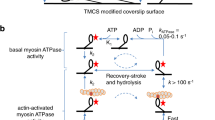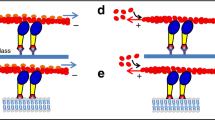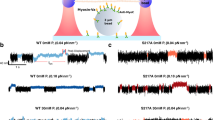Abstract
It has long been known that binding of actin and binding of nucleotides to myosin are antagonistic, an observation that led to the biochemical basis for the crossbridge cycle of muscle contraction. Thus ATP binding to actomyosin causes actin dissociation, whereas actin binding to the myosin accelerates ADP and phosphate release. Structural studies have indicated that communication between the actin- and nucleotide-binding sites involves the opening and closing of the cleft between the upper and lower 50K domains of the myosin head. Here we test the proposal that the cleft responds to actin and nucleotide binding in a reciprocal manner and show that cleft movement is coupled to actin binding and dissociation. We monitored cleft movement using pyrene excimer fluorescence from probes engineered across the cleft.
This is a preview of subscription content, access via your institution
Access options
Subscribe to this journal
Receive 12 print issues and online access
$189.00 per year
only $15.75 per issue
Buy this article
- Purchase on Springer Link
- Instant access to full article PDF
Prices may be subject to local taxes which are calculated during checkout




Similar content being viewed by others
References
Lymn, R.W. & Taylor, E.W. Mechanism of adenosine triphosphate hydrolysis by actomyosin. Biochemistry 10, 4617–4624 (1971).
Fisher, A.J. et al. X-ray structures of the myosin motor domain of Dictyostelium discoideum complexed with MgADP.BeFx and MgADP.AlF4−. Biochemistry 34, 8960–8972 (1995).
Dominguez, R., Freyzon, Y., Trybus, K.M. & Cohen, C. Crystal structure of a vertebrate smooth muscle myosin motor domain and its complex with the essential light chain: visualization of the pre-power stroke state. Cell 94, 559–571 (1998).
Geeves, M.A. & Holmes, K.C. Structural mechanism of muscle contraction. Annu. Rev. Biochem. 68, 687–728 (1999).
Volkmann, N. et al. Evidence for cleft closure in actomyosin upon ADP release. Nat. Struct. Biol. 7, 1147–1155 (2000).
Himmel, D.M. et al. Crystallographic findings on the internally uncoupled and near-rigor states of myosin: further insights into the mechanics of the motor. Proc. Natl. Acad. Sci. USA 24, 12645–12650 (2002).
Holmes, K.C., Angert, I., Kull, F.J., Jahn, W. & Schroeder, R.R. Electron cryo-microscopy reveals how myosin strong binding to actin releases nucleotide. Nature in the press (2003).
Reubold, T.F., Eschenburg, S., Becker, A., Kull, F.J. & Manstein, D.J. A structural model for actin-induced nucleotide release in myosin. Nat. Struct. Biol. 10, 826–830 (2003).
Coureux, P.D. et al. The myosin V motor visualized at 2.0 Å without bound nucleotide reveals a new structural state of myosin. Nature in the press (2003).
Rayment, I. et al. Three-dimensional structure of myosin subfragment-1: a molecular motor. Science 261, 50–58 (1993).
Houdusse, A., Szent-Gyorgyi, A.G. & Cohen, C. Three conformational states of scallop myosin S1. Proc. Natl. Acad. Sci. USA 97, 11238–11243 (2000).
Rayment, I. et al. Structure of the actin-myosin complex and its implications for muscle contraction. Science 261, 58–65 (1993).
Shih, W.M., Gryczynski, Z., Lakowicz, J.R. & Spudich, J.A. A FRET-based sensor reveals large ATP hydrolysis-induced conformational changes and three distinct states of the molecular motor myosin. Cell 102, 683–694 (2000).
Yengo, C.M., De La Cruz, E.M., Chrin, L.R., Gaffney, D.P. 2nd & Berger, C.L. Actin-induced closure of the actin-binding cleft of smooth muscle myosin. J. Biol. Chem. 277, 24114–24119 (2002).
Wakelin, S. et al. Engineering Dictyostelium discoideum myosin II for the introduction of site-specific probes. J. Muscle Res. Cell Motil. 23, 673–683 (2002).
Birks, J.B., Kazzaz, A.A. & King, T.A. 'Excimer' fluorescence IX. Lifetime studies of pyrene crystals. Proc. R. Soc. Lond. A 291, 556–569 (1966).
Lehrer, S.S. Intramolecular pyrene excimer fluorescence: a probe of proximity and protein conformational change. Methods Enzymol. 278, 286–295 (1997).
Kuhlman, P.A. & Bagshaw, C.R. ATPase kinetics of the Dictyostelium discoideum myosin II motor domain. J. Muscle Res. Cell Motil. 19, 491–504 (1998).
Malnasi-Csizmadia, A., Woolley, R.J. & Bagshaw, C.R. Resolution of conformational states of Dictyostelium myosin II motor domain using tryptophan (W501) mutants: implications for the open-closed transition identified by crystallography. Biochemistry 39, 16135–16146 (2000).
Kovacs, M., Malnasi-Csizmadia, A., Woolley, R.J. & Bagshaw, C.R. Analysis of nucleotide binding to Dictyostelium myosin II motor domains containing a single tryptophan near the active site. J. Biol. Chem. 277, 28459–28467 (2002).
Geeves, M.A., Jeffries, T.E. & Millar, N.C. ATP-induced dissociation of rabbit skeletal actomyosin subfragment 1. Characterization of an isomerization of the ternary acto-S1-ATP complex. Biochemistry 25, 8454–8458 (1986).
Taylor, E.W. Kinetic studies on the association and dissociation of myosin subfragment 1 and actin. J. Biol. Chem. 266, 294–302 (1991).
Cremo, C.R. & Geeves, M.A. Interaction of actin and ADP with the head domain of smooth muscle myosin: implications for strain-dependent ADP release in smooth muscle. Biochemistry 37, 1969–1978 (1998).
Geeves, M.A. Dynamic interaction between actin and myosin subfragment 1 in the presence of ADP. Biochemistry 28, 5864–5871 (1989).
Manstein, D.J., Schuster, H.P., Morandini, P. & Hunt, D.M. Cloning vectors for the production of proteins in Dictyostelium discoideum. Gene 162, 129–134 (1995).
Manstein, D.J. & Hunt, D.M. Overexpression of myosin motor domains in Dictyostelium: screening of transformants and purification of the affinity tagged protein. J Muscle Res. Cell Motil. 16, 325–232 (1995).
Malnasi-Csizmadia, A. et al. Kinetic resolution of a conformational transition and the ATP hydrolysis step using relaxation methods with a Dictyostelium myosin II mutant containing a single tryptophan residue. Biochemistry 40, 12727–12737 (2001).
Sarkar, G. & Sommer, S.S. The 'megaprimer' method of site-directed mutagenesis. Biotechniques 8, 404–407 (1990).
Acknowledgements
We thank W. Shih and J. Spudich for the cysteine-deficient construct and K. Holmes and R. Schroeder for the coordinates of their actomyosin model. We are grateful to the Wellcome Trust, the UK Biotechnology and Biological Sciences Research Council, the US National Science Foundation and the Magyary Zoltán Foundation for financial support.
Author information
Authors and Affiliations
Corresponding author
Ethics declarations
Competing interests
The authors declare no competing financial interests.
Rights and permissions
About this article
Cite this article
Conibear, P., Bagshaw, C., Fajer, P. et al. Myosin cleft movement and its coupling to actomyosin dissociation. Nat Struct Mol Biol 10, 831–835 (2003). https://doi.org/10.1038/nsb986
Received:
Accepted:
Published:
Issue Date:
DOI: https://doi.org/10.1038/nsb986
This article is cited by
-
Reversible movement of switch 1 loop of myosin determines actin interaction
The EMBO Journal (2007)
-
Switch movements and the myosin crossbridge stroke
Journal of Muscle Research and Cell Motility (2005)
-
The missing link in the muscle cross-bridge cycle
Nature Structural & Molecular Biology (2003)



